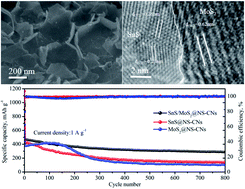Constructing an interface synergistic effect from a SnS/MoS2 heterojunction decorating N, S co-doped carbon nanosheets with enhanced sodium ion storage performance†
Abstract
Tin sulfide (SnS) has attracted much attention as an anode material for sodium ion batteries (SIBs) because of its various advantages, including high capacity and unique 2D structure. However, SnS has poor electrochemical performance caused by the large volume change and low intrinsic electric conductivity, which seriously limited its practical application in SIBs. Herein, we successfully constructed bimetallic sulfide SnS/MoS2 heterostructures decorating N, S co-doped carbon nanosheets (SnS/MoS2/NS-CNs) as anode materials for SIBs. The designed SnS/MoS2 heterostructures induce an electric field within the nanocrystals, which lead to lower ion-diffusion resistance and facilitate interfacial electron transport. Moreover, the N, S co-doped carbon nanosheets can buffer the volume change of SnS/MoS2, avoiding the direct contract between SnS/MoS2 and electrolyte, as well as favorable transport kinetics for electrons and ions. Accordingly, benefiting from these merits, the as-prepared SnS/MoS2/NS-CNs exhibit outstanding rate capability (372.9 mA h g−1 at 5.0 A g−1) and long-term cycling performance (287.2 mA h g−1 after 800 cycles at 1.0 A g−1).

- This article is part of the themed collection: Journal of Materials Chemistry A HOT Papers


 Please wait while we load your content...
Please wait while we load your content...